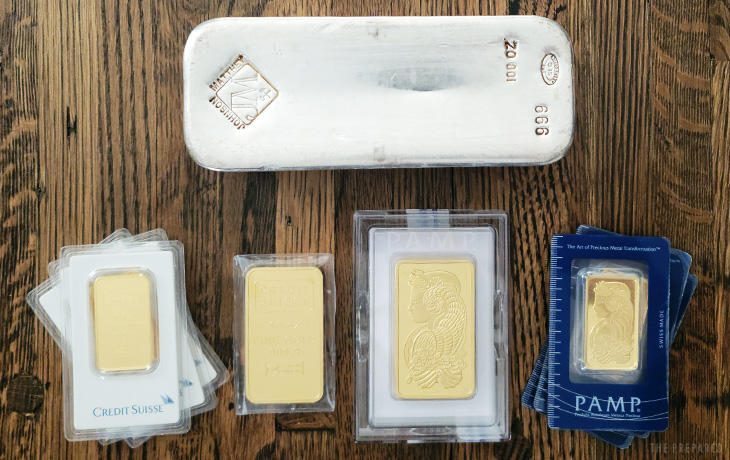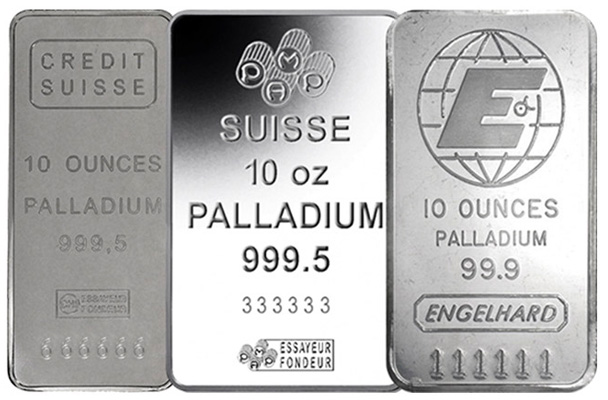This guide is not going to scare you into buying gold because the evil Federal Reserve is part of some Illuminati Deep State bla bla. It’s unfortunate that this market has been swamped with scammy people and false advertising that scares folks into doing dumb things with money (like some of our grandparents).
The role of precious metals in prepping is to be an insurance policy that pays off during broad economic problems, such as your country’s currency going haywire.
Similar to how you’d store gas at home in a proper gas can to handle a cyberattack crippling gas supplies across the East Coast, precious metals like gold, silver, platinum, and palladium are tangible things you can buy to handle macro economic problems. During the 1930s Great Depression, for example, gold prices went from $21 to $35. But it’s not always a sure thing, as it greatly depends on the nuances of the situation — gold did reach an all-time high in 2011 after the Global Financial Crisis (going from $1,000 to $1,870 in a few years), but it didn’t perform any better than the broader stock market recovery.
If, for some reason, other people or other countries and world markets stop valuing your form of currency, having some of your wealth in the form of metals — which other people/places might still value — means the wealth at your disposal didn’t crash as much as it would’ve if you had all your eggs in one basket. You’re still going to take a hit on your other assets, but at least this will soften the blow and provide liquidity options.
You shouldn’t consider buying metals until you’ve got your personal financial foundation in order (eg. no high-interest credit card debt), have covered the beginner prepper checklist, and have at least a few week’s worth of expenses set aside in cash. Ideally you’re also making progress on your retirement and health savings before buying this insurance, too.
Even then, it’s fine if you have no metals at all. Cryptocurrency is a modern alternative that can fill many of these same roles. Or you can skip alternative currencies entirely and focus more on the core stuff like food and water.
Don’t think of metals as an investment, but rather a store of value. Yes, they will likely appreciate over time where you could sell for a profit. But there are better ways to invest if your primary goal is to grow your money before retirement or SHTF, such as the stock market and real estate.
Another common mistake is thinking of gold and silver as a form of post-collapse currency. First, keep the sane prepping mantra in mind and recognize that chances are very slim we end up at the point where the world is using non-paper-money as the main store of value. (The US Dollar hasn’t been tied to gold since Nixon moved away from the Breton Woods gold standard in the 1970s.)
Second, if we do get to that point, gold and silver are probably not going to make a comeback like some ancient Roman coin — if things are that bad, people will barter or trade based on commodities like food, water, or caffeine 😉
In the Denzel Washington movie Book of Eli, the local shopkeeper doesn’t accept payment in cash or gold. They’re literally bartering in the form of disposable wet wipe packets (towards end of scene).
More: Best survival movies
The most important bits:
- If you choose to hold metals at all, most reasonable people hold around 1-3% of their net worth in this form.
- If you’re into cryptocurrency, you should think of crypto and metals in the same spiritual category in your overall portfolio, since both are preps for local fiat problems and inflation.
- Most people’s combined mix of rainy day cash savings + metals + crypto is less than 6-10% of their net worth.
- Whatever you buy, make sure you take physical possession of it. If you can’t hold it in your hand, it’s not really yours. Experts recommend avoiding things like bank vault boxes and securely storing at home instead.
- If the metal arrives in a sealed plastic container, leave it in! Opening it might hurt the value, even to the point a buyer wouldn’t take it without being re-assayed (re-measured) for purity.
- Metals are pretty durable and typically don’t have special storage needs other than security. But you can keep metal lookin fancy with plastic protectors like these Air-tite holders for American Eagle coins.
- Most people buy coins or bars in 10 gram, 1 oz, 10 oz, and 100 oz varieties, with 1 oz options being the most common because it’s a decent sweet spot of economics and carrying weight.
- Pick from gold, silver, platinum, and/or palladium. There are others, but they aren’t a fit for prepping.
- Don’t pay a premium for limited editions, fancy designs, etc. Keep it simple — the point is the metal, less so the veneer.
- Since you want it to be easy to sell when the time comes, choose products from recognizable, trustworthy entities such as the US Mint or Switzerland’s Credit Suisse. A potential buyer might not believe your gold bar stamped with “Nigerian Mint” is real.
Best online stores to buy gold and silver
Although you can buy locally, most people find the best deals online. There’s a growing number of reputable sellers — you should always check things like Better Business Bureau reports — but these shops are popular and used by members of the TP community:
Make sure you take physical possession and try to store metals safely at home
If you buy 1 oz of gold, you should end up with 1 oz of gold you can hold in your hand and stash at home. Some services will “hold your metals for you” as a custodian. That’s obviously a bad choice in general, let alone as a prep for when things get bad.
You can also invest in metals through the stock market (eg. the GLD ETF) and instruments like futures and derivatives. That might be fine purely from an investment perspective, but again, it’s less preferable for prepping.
If you buy online, the vendor will simply mail it to you in a normal nondescript box. Smaller purchases often come in those common, small, and white US Postal Service boxes. Obviously it’s a good idea to use insured shipping with signature delivery.
There’s cost and risk to storing metals at home, namely the cost of security containers and the risk of loss due to theft or natural disaster. But many people feel this risk is outweighed by the risk of keeping their last-resort financial safety net in the hands of untrustworthy people or organizations.
In the years after the 2008 Global Financial Crisis, for example, the Greek government took money from private citizen’s bank accounts and limited daily cash withdrawals.
And while we were writing this article, the FBI seized hundreds of innocent people’s bank boxes even though their warrant prohibited it.
Shapes, sizes, and designs
Metals are usually in the form of currency coins, rounds (which look like coins but aren’t real currency), and bars or ingots. Bullion is a common word that simply means raw ore that has been refined so that what you’re holding is 99.xx% pure.
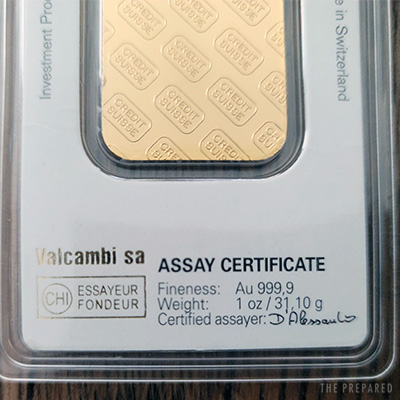
Troy Ounce is slightly different from the normal ounce unit of measurement. Troy has been used to weigh precious metals since the Middle Ages, and they haven’t updated it in order to keep things consistent over history. A troy ounce is around 31 grams, while a normal ounce is 28.35 grams.
You might run across karats for gold (as opposed to carats for gems/diamonds). 24-karat gold is pure, and a number less than 24 means the gold has been diluted.
If you’re starting with a smaller budget, you might buy pieces measured in grams. eg. At the time of this writing, a 10 gram gold bar costs about $620.
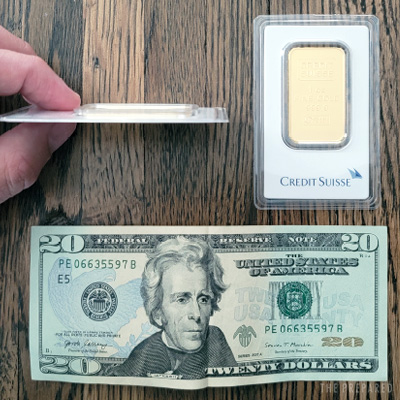
The next step up is measured in ounces. One ounce (1 oz) coins and bars are very popular and currently around $1,900. You’ll also see bars in 10 and 100 oz varieties.
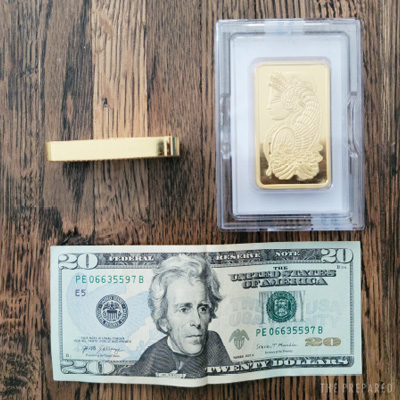
Consider how much space you have to securely store your metals, and how you might use and transport them later when SHTF. Similar to cash denominations, ideally you’d have a mix of sizes so that you can adapt on the fly. Maybe you only need to pay someone enough for a cow or ride on their vehicle — you don’t want to use a 10 oz gold bar to pay for that, especially since change is unlikely.
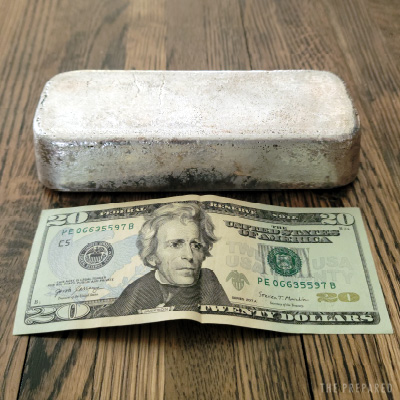
Different metals have different value-to-weight ratios. A 10 oz gold bar worth $19,000 can easily fit in your pocket, while a big 100 oz silver bar is only worth $2,700 and would slow you down on foot.
Another example: A 1/10-ounce American Gold Eagle coin, about the size and weight of a dime, is worth an entire stack of Silver Eagle coins.
Other than a few exceptions like the American Eagles, Canadian Maples, or potentially equivalents from Australia and South Africa (if you live in those regions), avoid anything with a fancy design and stick with the basics.
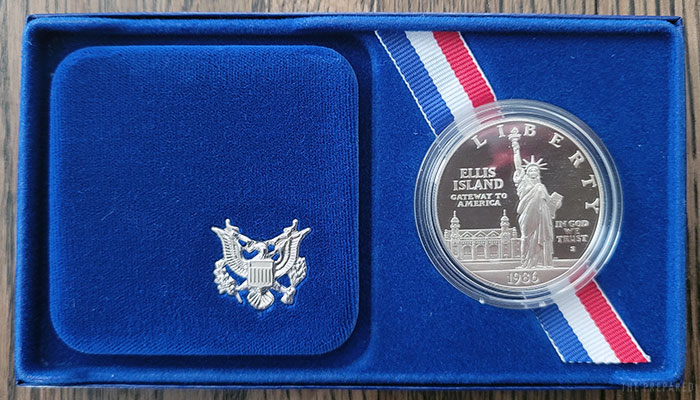
More buying tips
- “Spot” is the current market price for raw metal. “Premium” is what you pay above the spot price. If silver has a spot price of $28 an ounce, you might end up paying $30 an ounce to cover the broker’s costs and profit margin.
- Besides broker costs, you might also pay a premium above the spot price if the product you’re buying is more valuable than a chunk of raw metal, such as a shiny collector’s coin.
- Vice versa, if you’re buying generic bars/rounds — something unmarked or marked with the logo of a private company like AMPEX — you want to buy as close to spot price as possible.
- You generally want to avoid specialty products with a high premium. If you need these metals in a prepping context, that probably means buyers don’t care whether a piece of gold is a limited special edition bla bla — they just want the gold for its usefulness. So don’t bother paying a premium now that won’t give you value later on.
- However, there are a few products worth their premium, namely the American Silver Eagle and American Gold Eagle coins (ASE and AGE), as well as the similar Canadian Silver and Gold Maples. They hold their premium well because they’re hard to counterfeit, people recognize/trust those coins, and there’s a liquid market (meaning it’s not hard to sell when you want to).
- Trust matters, especially when SHTF and normal people are wondering if the metal you’re trying to give them is real. The people you might need to sell these to are more likely to trust products that come from official mints of stable governments or well-known companies such as Credit Suisse, rather than generic rounds and bars.
- A cheap way to acquire silver is so-called junk silver, which is older US coins made partially of silver. Go to your bank and get $100 in change.
An easy way to test metals you buy in person is to try to attach a magnet to them. Cheap steel will stick to the magnet and non-ferrous aluminum is too light to fool you. - Keep metals in plastic protectors or some other kind of case to keep them clean and shiny. It doesn’t affect the price of silver per se, but people are more likely to buy a shiny, unblemished coin. Air-Tite is the standard.
Why do these metals have value? Isn’t it just made up, like fiat?
There’s a difference between why gold and silver were used as universal money in ancient times versus why these kinds of metals still have value today.
Humanity wasn’t nearly as good back then at mining and processing metal. Basic advancements were so monumental — think on the scale of how the internet has changed everything — that entire eras were defined and named by them (eg. Bronze Age).
Gold and silver were rare enough to hold value through scarcity — price/value craters with too much supply — yet they were accessible enough to be used at that point in history. Gold, for example, is known to be durable and easy to work with, a big advantage over other materials for making basic jewellery and currency with primitive skills.
Today, the value lies much more in how these metals are useful for industrial applications.
Pick from gold, silver, and the platinum family
The platinum family includes platinum itself and palladium, ruthenium, rhodium, and iridium. Palladium and platinum are the most common, and we recommend avoiding the lesser-known ones.
These half dozen or so metals are what people buy because they are rare, valuable, tradeable, often have qualities like rust/corrosion or radiation resistance, and can be polished to a pretty shine.
The industrial uses are what’s important for holding value after SHTF:
- Gold is durable and does not rust or corrode. It’s malleable and conductive, often used in electronics, insulation, and radiation shielding.
- Silver is the most electrically and thermally conductive element, used in batteries, solar panels, and other electronics.
- Platinum is the rarest of all precious metals (15x rarer than gold) and features high heat and corrosion resistance. Besides automotive uses, platinum is used for things like medical devices and weaponry.
- Palladium can absorb 900 times its volume in hydrogen, which is why it’s mostly used in the catalytic converter / pollution control devices included in almost every car on the planet.
Things would have to get really bad to get to the point these metals don’t have value. It would mean we’re no longer mass producing electronics or green energy devices, for example.
We do wonder, though, about how future changes in technology will affect demand — eg. silver was widely used in photography until the digital camera killed film. Though silver had enough other uses to continue to climb in value.
A good example is palladium, widely used today to control carbon emissions from fossil-fuel burning engines. But 30 years from now, when the world has hopefully broken it’s dependence on burning those fuels, will palladium still be worthwhile? It has other uses, such as in carbon monoxide detectors and biology labs, but it’s hard to predict how market changes will affect price.
That said, these are the four recommended metals because they have the highest likelihood of staying valuable for a long time.
Want to learn more?
There’s a lot of info online about investing in precious metals, although it can be hard to dig through the junk. Check out the sources below:
